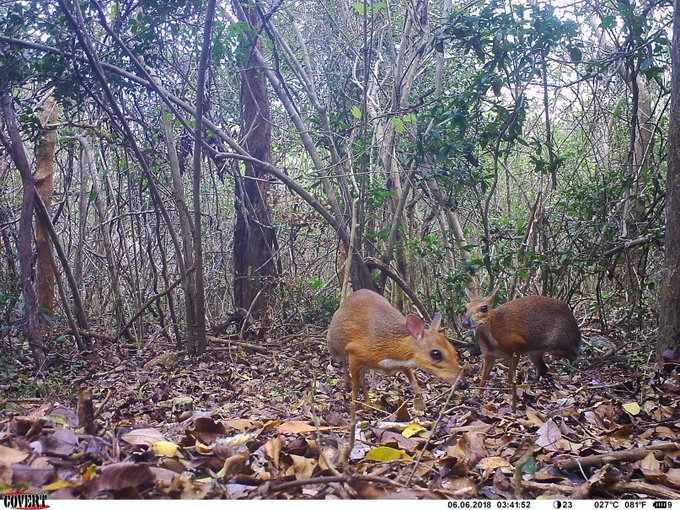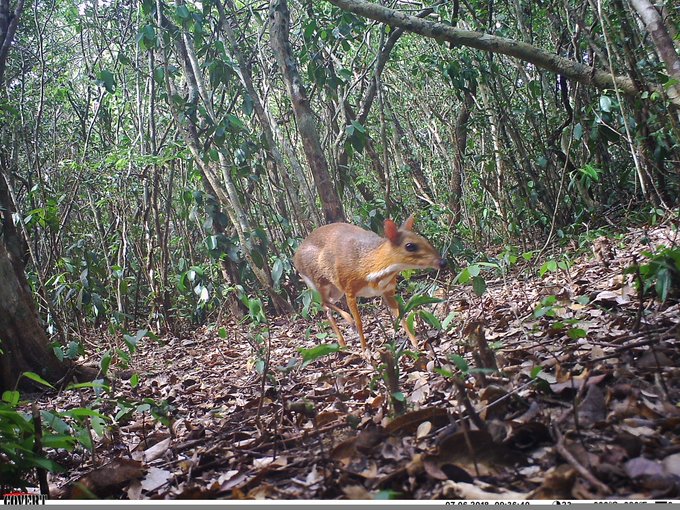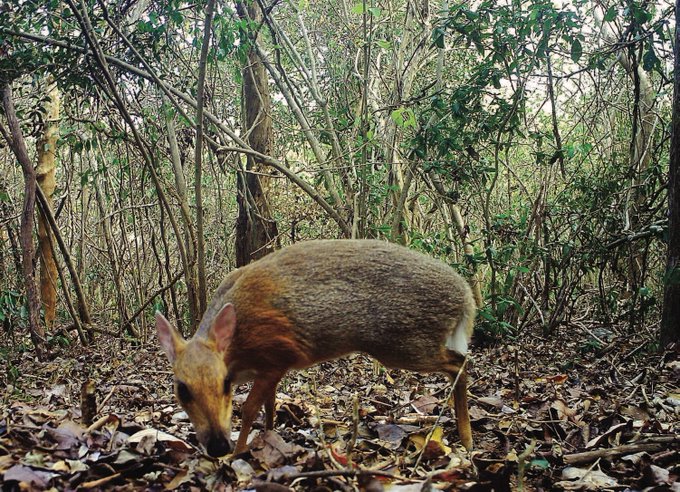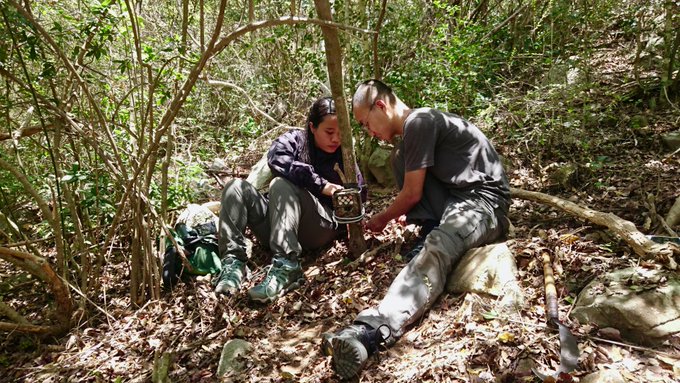It’s estimated that over 8.7 million species inhabit Earth, but thanks to hunting, deforestation and global warming, it’s estimated that one in five of those species currently faces extinction. But there are some hardy animals long thought extinct that have come back from the brink, and not all of them are friendly. Let's explore 10 incredible cases of animals that were once thought to be extinct but are still alive and have been caught on camera.
10. The Cuban Solenodon
The Cuban Solenodon was considered one of the most ancient mammals known to man, and it had the features to prove it. While early engravings of the 30-centimeter-long, nocturnal mammal make it seem like it may have been related to an anteater or Pinocchio, it was actually closer to a hedgehog or a mole.
This is because, like its cute but unsuspecting brethren, it had a venomous bite which it used to subdue its prey. But all the venom in the world couldn’t protect it from deforestation, habitat degradation and attacks by much larger feral cats, rats and dogs. Slowly, sightings of the Solenodon dropped to zero.By the 1970s many believed the species had gone extinct. But after a decade-long intensive quest, Cuba's Ecology Institute managed to capture the first-ever photo evidence that the Cuban Selodon was alive and biting. Through rigorous testing, they determined the creature has barely changed in appearance from 76 million years ago!
9. The Fernandina Island Tortoise
You’ve got to be pretty hard, or pretty dumb, to make an active volcano your home. And for thousands of years that’s just what the Fernandina Island Tortoise did. Last seen over a hundred years ago, these gigantic armored reptiles could live up to 200 years and weigh up to 417kg, which is about 6 full beer kegs!
They settled on the third largest Galapagos Island which was also home to La Cumbre, one of the most active volcanoes in the world. It’s not known exactly what killed them off, but we can take a strong guess.
Originally, the species was identified on a 1906 expedition which found a solitary male specimen. This was an incredible discovery, which they surprisingly killed.
That’s right. In fact, the crew killed every tortoise they found on their expedition in the name of scientific research. Future scientists really began kicking themselves as there wasn’t a single sighting of this rare reptile for over a hundred years that followed, until February 2019.Rangers from the Galapagos National Park, led by wildlife biologist Forrest Galante filming for Animal Planet’s ‘’extinct or alive’’,
caught on camera just one solitary female who they estimate is over 100 years old!
Learning from their predecessor’s mistakes, they’ve moved her to a secure breeding facility. There are markings on the island to indicate more surviving tortoises, but as of yet, none have been found.
8. The Australian Night Parrot
Described only a handful of times in recorded history, the Australian Night Parrot did just what it said on the tin. It roams around Western Australia at night, and, despite being unable to fly, it shares similar physical traits with other parrots.
But the last living specimen disappeared without a trace in 1912. Then suddenly in 2013, photographer and ecologist John Young was the first to capture photographic evidence of the elusive bird along with carefully documented nesting sites. It was the first hard proof the bird still existed in more than a century and spurred more ecologists to spend hours of time and effort to capture footage of these unbelievably rare birds.
But in March 2019,
according to an expert panel convened by the Australian Wildlife Conservancy, Jon Young made most of his findings up. Allegations arose that Young had botched call recordings, planted feathers, and even created a fake nest and eggs to make the discovery seem even more impressive. As if rediscovering a previously thought extinct animal wasn’t impressive enough. It turns out he’s previously been accused of manipulating bird photos and may have seen the rediscovery as a shot at redemption. Shouldn’t have put all his eggs in one basket.
7. The Terror Skink
The aptly named Terror Skink was discovered all the way back in 1872 and was known only for a single specimen collected from New Caledonia. Originally dubbed ‘Bocourt’s Terrific Skink’, it was described as being over 50cm long and having long curved anterior teeth, making it a predatory nightmare of other lizards.
Since then, the name seems to have quickly changed. But after 1872, and subsequent explorations of New Caledonia, no other Terror Skinks were sighted or reported anywhere on the island. Similar to The Fernandina Tortoises, it could have been the very last one of its kind swept up by an expedition crew!Fortunately, some real scientists accidentally discovered the terror skink during their expedition on the island in 2003 and, by being good at their job, didn’t kill it. In fact, they returned to the island several times to document and study it.
They deduced that these fearsome-looking reptiles were some of the top predators in their ecosystem, despite being incredibly rare and small in number. So much so, there have only ever been 7 recorded sightings of it in the wild!
6. The New Guinea Wild ‘Singing’ Dog
Now this is an animal of great debate for biologists all over the world. Very little is known about the species, even though it was discovered over a hundred years ago in the Star Mountains region of Papa New Guinea.
The specimens ‘collected’ (well, killed) at the time were an amazingly genetically divergent species of the gray wolf! But they were noted for their unusual flexibility which unlike most dog species makes them adapted to climbing and jumping.

However, what was said to really set them apart was their terrifying, but melodious howl which sounds like humans after stepping on Lego. But sightings began to dwindle, not just because their habitat was considered one of the wettest places on earth, but also because it was entirely possible that with increasing weather anomalies in the region the Singing Dogs had been wiped out.No sightings of the dogs were recorded for over 23 years, when in 2012 an incredible photo appeared almost by accident from Tom Hewitt, who stumbled across a lone Singing Dog during his trek through the Star Mountains. Scientists were able to breathe a sigh of relief knowing the species was still capable of existing in the wild, but its exact numbers are completely unknown.
5. The Pondicherry Shark
Unbelievably, this was a species that was once believed to have thrived in its habitat. A small shark by comparison to other variants of the species, the Pondicherry Shark was first discovered around the 1840s and had an incredibly robust build.
Their circular eyes were equipped with nictitating membranes, acting as a third eyelid to maintain excellent vision, making it a once ideal killing machine in the murky Indo-Pacific waters. However, its small size made it an easy target for humans.
They were hunted without restraint, but for over 40 years not one accurate sighting was reported of the Pondicherry Shark, and scientists began to give up hope of ever being able to spot one in the wild ever again. But fatefully in July 2019, wildlife biologist Forrest Galante set out on an expedition to find and document the superseded shark. After collating over three years of research, Galante’s efforts paid off as he caught what is believed to be one of the last remaining Pondicherry Sharks in existence. It was a death-defying journey, making this find even more important and impressive!
4. The Zanzibar Leopard
It’s hard to believe a top predator can swiftly become prey, but that’s exactly what happened to the legendary Zanzibar Leopard. From its discovery on the island of Zanzibar, Tanzania in 1758, it was labeled as the island's Apex predator.
Its rosette-spotted fur made for perfect camouflage in the dry foliage of Zanzibar, and like most cats, its powerful jaws and claws made it a ferocious carnivore.
But vicious rumors among the locals of the island set a dangerous widespread belief that the Leopards were kept by witches, and during the Zanzibar revolution of 1964 a combined anti-witchcraft and leopard-killing campaign led to hunts that chased the Leopards population to the brink. By the mid-1990s, authorities had given up hope and listed the species as extinct.
Enter our hero of the hour: Forrest Galante. To prove not all hope was lost, Galante’s team set up trip camera devices to capture footage of all possible wildlife across the island. Analyzing over two weeks of footage, Galante finally captured the only live photographic evidence of this leopard to date.
Wildlife Expert Catches 'Extinct' Zanzibar Leopard on Camera by Inside Edition Close study of the video shows that this cat is smaller than an average African leopard, in line with what Zanzibar leopards were, or are.
3. The Rio Apaporis Caiman
So much about this mysterious crocodile species remains unknown that it’s unbelievable it was ever found! Known predominantly for the unusually long and narrow morphology of its head and combined with its unusual yellowish skin, there was no other crocodile in the world that boasted such striking features.
But aside from that no other information really existed on this animal; no photographs, no real description, it isn’t even known how long they lived! So, in the 1980s, when no sightings had been reported for several years, fear began to mount that the population may have been affected by the Guerrilla warfare going on in its habitat of the Colombian Amazon Rainforest.
As years went by without a single sighting, the lost Caiman was sadly listed by several authorities as extinct.
But he’s not done yet! Once more to the rescue, Forrest Galante and his team went to incredible lengths to find this beast. In December 2019, after years of research and planning, Galante’s team spent weeks searching for any sign this crocodile had survived. Before almost calling it quits, Galante was able to actually capture (and release!) a living specimen and bring some of the only footage ever caught of this supposedly extinct reptile to the world.
2. The Wondiwoi
Kangaroos; they are the springy marsupials that just hop along the ground, right? Wrong! The ultra-rare Wondiwoiis a Tree Kangaroo that was last seen in this remote mountain range in West Papa, New Guinea by German biologist Ernst Mayr in 1928 who, naturally, shot and killed it.
Embed for https://twitter.com/JZoology/status/1031590575559122945 could not be displayed
As you can see from the above drawing, the bizarrely miniature, rodent-like kangaroo was described to have had a beautiful reddish-gold coat, and shared common features with its Kangaroo cousins such as powerful hind legs, large claws and a strong tail. Locals of the region rarely visited its secluded mountain home as it lived in such difficult mountainous terrain. So, with fewer and fewer sightings, it appeared to have vanished from its known habitat and became listed as one of the
25 Most Wanted Lost Species.
That is, until recently.
In 2018, the incredibly unsuspecting botanist Michael Smith miraculously stumbled upon it, and then shot some pictures of it! It was found seven thousand feet up into a forest of dense bamboo thickets. That’s a hide-and-seek champion if ever there was one.
1. The Silver-Backed Chevrotain
This animal is also known as the Mouse Deer. When you think of a deer, you probably imagine something elegant, grand, graceful and not a rabbit-sized creature. From the tip of its snout down to the comparatively minuscule hooves, these ankle-high creatures appeared to be pint-sized deer. On average they’re about a 23rd of the size of the deer we know, weighing around an absurd 5 pounds!
They had never been photographed in the wild and were only known because five specimens that were found were killed during a 1910 scientific exploration. But increasing deforestation of its natural habitat in Vietnam and intensive hunting meant no sign was seen of the rare species for almost one hundred and ten years.
But then the unimaginable happened. In November 2019, a research team was able to capture the first-ever live photos of this incredible animal using camera trap technology.
The photos showed at least two currently exist, but with the fear that this rediscovery will bring avid hunters back into the picture, no data about their exact whereabouts or estimated remaining numbers haS been released. Which begs the question, are these the last ever photos we’ll see of the Mouse-Deer?
If you ever come across a supposedly extinct animal, just don't kill it, for the sake of conservation. Don't shoot the poor creature, shoot a picture instead. Thanks for reading!
































